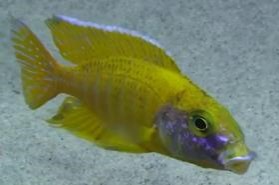Nkhomo-benga peacock facts for kids
Quick facts for kids Nkhomo-benga peacock |
|
|---|---|
 |
|
| Conservation status | |
| Scientific classification |
The Nkhomo-benga peacock (Aulonocara baenschi) is a special kind of fish. It's also called the new yellow regal peacock. This fish is a cichlid, a type of fish found in fresh water. It lives only in Lake Malawi in Africa. Sadly, this beautiful fish is in danger. People catch too many of them for fish tanks.
Contents
Where This Fish Lives
The Nkhomo-benga peacock lives only in Lake Malawi. It has only been seen around the Nkhomo Reef. This reef is in the western part of Lake Malawi. It might also live in other nearby spots.
About the Nkhomo-benga Peacock
This fish has a scientific name: Aulonocara Baenschi. Its common name is the Yellow Sunshine Peacock.
Fish Facts
- Adult Size: About 5 inches long.
- Life Expectancy: Can live up to 10 years.
- Home: East African Lake Malawi.
- Minimum Tank Size: Needs at least a 50-gallon tank.
Ideal Water Conditions
- Temperature: Around 78°F (25.5°C).
- pH Level: Between 7.0 and 8.0.
- Water Hardness: From 10 to 25°.
Fish Behavior
The Nkhomo-benga peacock is usually peaceful. But it can become a bit aggressive. This often happens when it's protecting its space. It's especially territorial when it's ready to lay eggs.
What They Eat
These fish are carnivores, meaning they eat meat. They love live foods like bloodworms or snails. They also enjoy brine shrimp. They will usually eat frozen, flake, or pellet foods too.
Habitat and How They Find Food
The Nkhomo-benga peacock lives in sandy areas. These areas have rocks scattered around. The fish hunts for small invertebrates in the sand. It uses special pores on its head to find them.
It can find food in two ways. It might sift through the sand with its mouth. Or, it can watch the sand for movement. When it sees something, it quickly grabs its prey.
These fish usually live in shallow water. You can find them about 2 to 6 meters (6.5 to 20 feet) deep. But they have been seen as deep as 16 meters (52 feet).
Reproduction and Life Cycle
Male Nkhomo-benga peacocks are very territorial. They keep their bright breeding colors all year. Each male builds a shelter by digging in the sand. This shelter is the center of his territory.
Female fish live in small groups. When a male tries to attract a female, he performs a courtship dance. If she likes him, she will lay her eggs. Then, she quickly takes the eggs into her mouth.
The males have spots on their anal fins that look like eggs. The female is attracted to these spots. She tries to swallow these "eggs" from the male's fin. When she opens her mouth, the male releases his milt. This fertilizes the eggs that are already in her mouth.
The mother fish keeps the eggs in her mouth for about four weeks. This is called mouthbrooding. After this time, she releases the baby fish, called fry. They are then ready to swim freely.
Threats to This Fish
The biggest danger to the Nkhomo-benga peacock is people catching them. They are caught for the aquarium trade. This species is now considered critically endangered. This means it's at a very high risk of disappearing forever.
Why the Name "Baenschi"?
The second part of the fish's scientific name, "baenschi," honors a person. It's named after Ulrich Baensch. He invented a popular dried flake fish food called Tetramin. He also started the company Tetra GmbH.
See also
- List of freshwater aquarium fish species


